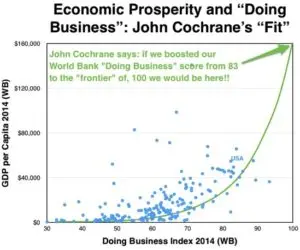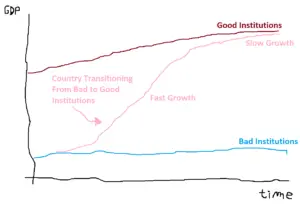Bad Economics: US could be at $160k GDP/capita, says John Cochrane
Economist John Cochrane wrote a WSJ article where he – no joke-- argues that the US GDP per capita could be around $160,000/year if it weren’t for that damn meddling government. He argues that regulations are solely to blame for low economic growth with this sort of rigor:
America is middle-aged and overweight. The first camp says, well, that’s nature, stop complaining. The second camp looks for the latest miracle diet—try the 10-day detox cleanse! The third camp says get back to the tried, true and sometimes painful: eat right and exercise.
But his point is better illustrated in one chart:

This plots the world bank “Ease of Doing Business” (EDB) score against GDP per Capita. He uses this to make the ridiculous log-linear extrapolation that increasing the United States’ EDB score would significantly increase its GDP per capita.
This, concerningly, has been called a “nice piece” by Greg Mankiw.
The data looks appropriately insane if we make the graph y-axis linear instead of logarithmic, as Brad DeLong puts it:

Cochrane responds that even though his analysis is whacky:
the local derivative is still high, no matter how you fit the “out of sample” points. If you don’t think you can draw the line out to 100, going from 82 to 83 still has very large effects.
Which is a truly underhanded way of admitting you were lying with data. But I think it’s interesting to go into exactly how wrong it is.
Do institutions affect growth?
Yes.
The classic book Why Nations Fail makes the case that countries prosper by having “inclusive” economic institutions that foster development. The worst critics of the theory come up with is stating that it’s one important factor among a few others.
Then why is Cochrane Wrong?
The institutions mostly decide the steady state of the economy, that is the level of wealth you will end up at. While a rich country’s economic growth is mainly limited by technological progress, a poor country transitioning to become a rich country can experience fast growth “on the way up”. This is best pictured by one of my famous shitty MS Paint graphs:

Once you have good institutions, it’s hard to have high economic growth. So when Cochrane says:
From 1950 to 2000, the U.S. economy grew at an average rate of 3.5% annually. Since 2000, it has grown at half that rate—1.76%.
Assuming he remembers undergraduate macroeconomics, he’d see we’re at the upper right of the pink curve and a country in transition towards well developped institutions would have higher growth. We can see this story in the US historic growth rate chart.
John doesn’t understand the EDB index
You might argue that if only we had “better” institutions, we could shift the “steady state” to untold wealth. The problem with that idea is there’s no country with a data point showing its absurdly higher GDP/capita than the current state. But some of those countries have to be setting the frontier score in the index! So the “local derivative”, as John says, is necessarily a small.
The EDB index is fundamentally not made as a way measure distance between countries. By it’s made to rank countries against each other[footnote]In mathematicians’ terms, the EDB is an “ordinal” numbering, not a “cardinal” numbering[/footnote].
The EDB is made of statistics like “time to start a business” or “cost of construction permits”. If you’re blending hours and dollars together into one number, it makes no sense to have a notion of “distance” between two index values. The World Bank instead ranks countries by which percentile they fall into on each statistic to make the final index.
The Frontier Score basically calculates the average percentile distance from the best score on each value.
If the US were to have a frontier score of 100, it would have the business procedures of New Zealand, the border compliance of France, and the protection to minority investors of Cambodia. But somehow it would end up with more than twice the GDP per capita of any of those countries.
This extrapolation seems insane because it is insane. To lighten the mood, I’ll end with a spiteful joke:
Person: John! I have a problem–
Cochrane: Regulations!
Person: Actually my drain is clogged
Cochrane: That’s still the regulations’ fault
P.S.
I decided to try running the numbers myself with the World Bank GDP and EDB Frontier data and get this model fit (for a 2nd-degree polynomial fit):

Which predicts a fairly sane $84,000 GDP per capita at a perfect frontier score.
